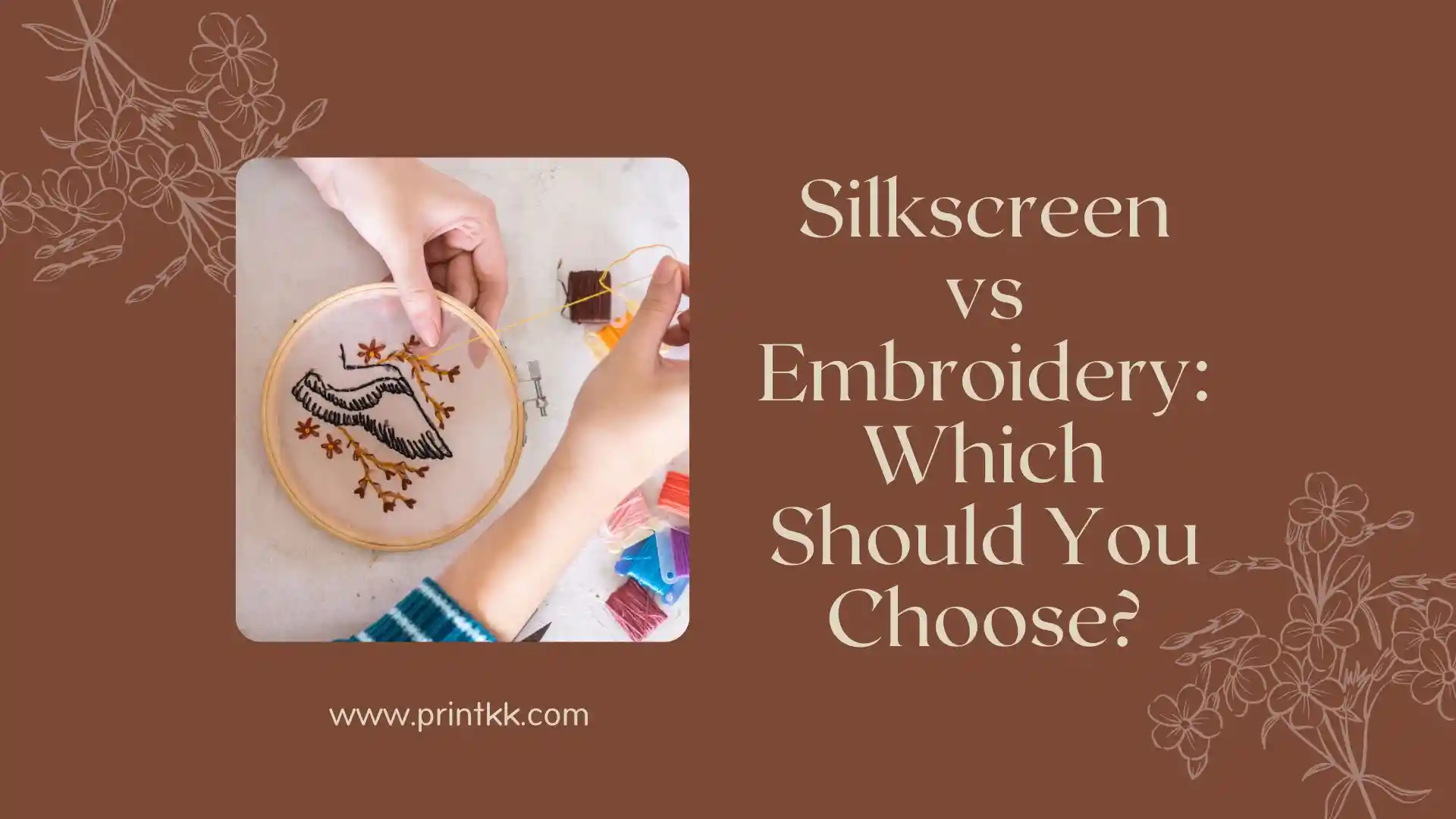
When it comes to customizing apparel, choosing the right method can make a big difference. In the debate of silkscreen vs embroidery, each technique has its own strengths.
Your design, fabric, and intended use will determine which method delivers the best results. This guide breaks down the key differences, helping you decide which approach is right for your custom shirts, hats, or other apparel.
What is Embroidery?
Embroidery is the art of using thread to build a design that actually becomes part of the fabric. Instead of laying ink on top, you're stitching color into the material itself.
That's why embroidered logos on polos or caps look more premium and feel slightly raised under your fingers.
Modern embroidery machines follow digital stitch files, so every detail—from letter thickness to thread direction—affects how the final piece looks. It's best for structured fabrics that can handle tension, like cotton or twill.
On stretchy knits, it can pull or distort the shape if not stabilized. Think of embroidery as design with texture, built to last.
The Pros and Cons of Embroidery
The Pros of Embroidery
- Built to last: Embroidery doesn't fade or crack the way prints can. If you're making work uniforms or hats people wear often, this method holds up.
- Adds real texture: Thread gives depth you can feel. A small stitched logo can make a plain hoodie look intentional and branded.
- Polished impression: Embroidery looks sharp on polos, jackets, and caps—places where you want to appear professional without looking flashy.
- Low waste for small batches: Since each piece is stitched, you can produce a few at a time without worrying about setup costs or leftover ink.
The Cons of Embroidery
- Limited detail: Fine gradients or photo-style images won't translate well in thread.
- Can distort thin fabric: Lightweight T-shirts or stretchy material may pucker around the stitches.
- Costs add up: More stitches mean higher pricing, especially for big designs or multi-color logos.
- Not for every style: If you want a bold, streetwear feel, embroidery can look too formal or traditional.
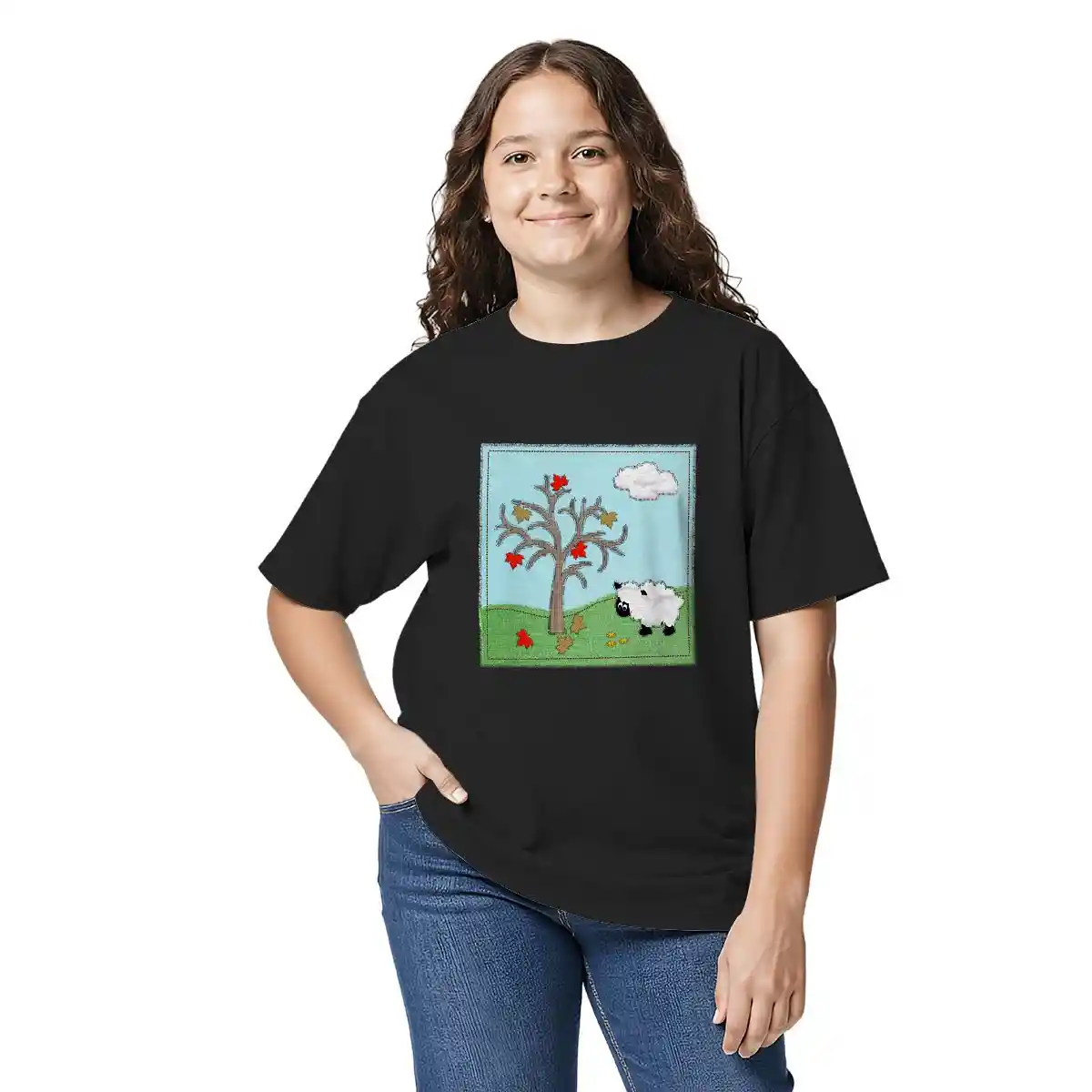
Custom Kids' Cotton T-Shirt (Made in USA) - Print-On-Demand - PrintKK
What is Silkscreen?
Silkscreen printing, also called screen printing, uses a fine mesh screen to press ink onto fabric.
Each color in your design needs its own screen, which means the process works best for bold graphics and solid colors.
You place a stencil on the screen, spread ink across it with a squeegee, and the ink passes through only the open areas to form your design. The printed layer sits on top of the fabric, giving it a slightly raised feel.
This method is valued for strong color coverage and durability, especially on cotton or cotton-blend materials. If you're printing many shirts with the same design, silkscreening is one of the most efficient and consistent ways to do it.
The Pros and Cons of Silkscreen
The Pros of Silkscreen
- Colors stand out: Bold, solid shapes look crisp, and dark fabrics don't dull the design. You can make a simple logo feel striking.
- Cost works in your favor for big orders: Once the screens are ready, printing dozens or hundreds of shirts becomes much cheaper.
- Flexible materials: Cotton, polyester, even canvas—silkscreen adapts without losing quality.
- Quick for repeats: If you need the same design on many items, the process is fast once set up.
The Cons of Silkscreen
- Setup isn't cheap for small runs: Printing a handful of shirts can feel costly because each design needs preparation.
- Not for fine detail: Tiny text, gradients, or photo-like designs don't translate well.
- Can fade or crack: Heavy washing or stretching can wear the ink over time.
- Limited layering: Too many colors or intricate overlaps increase both complexity and cost.
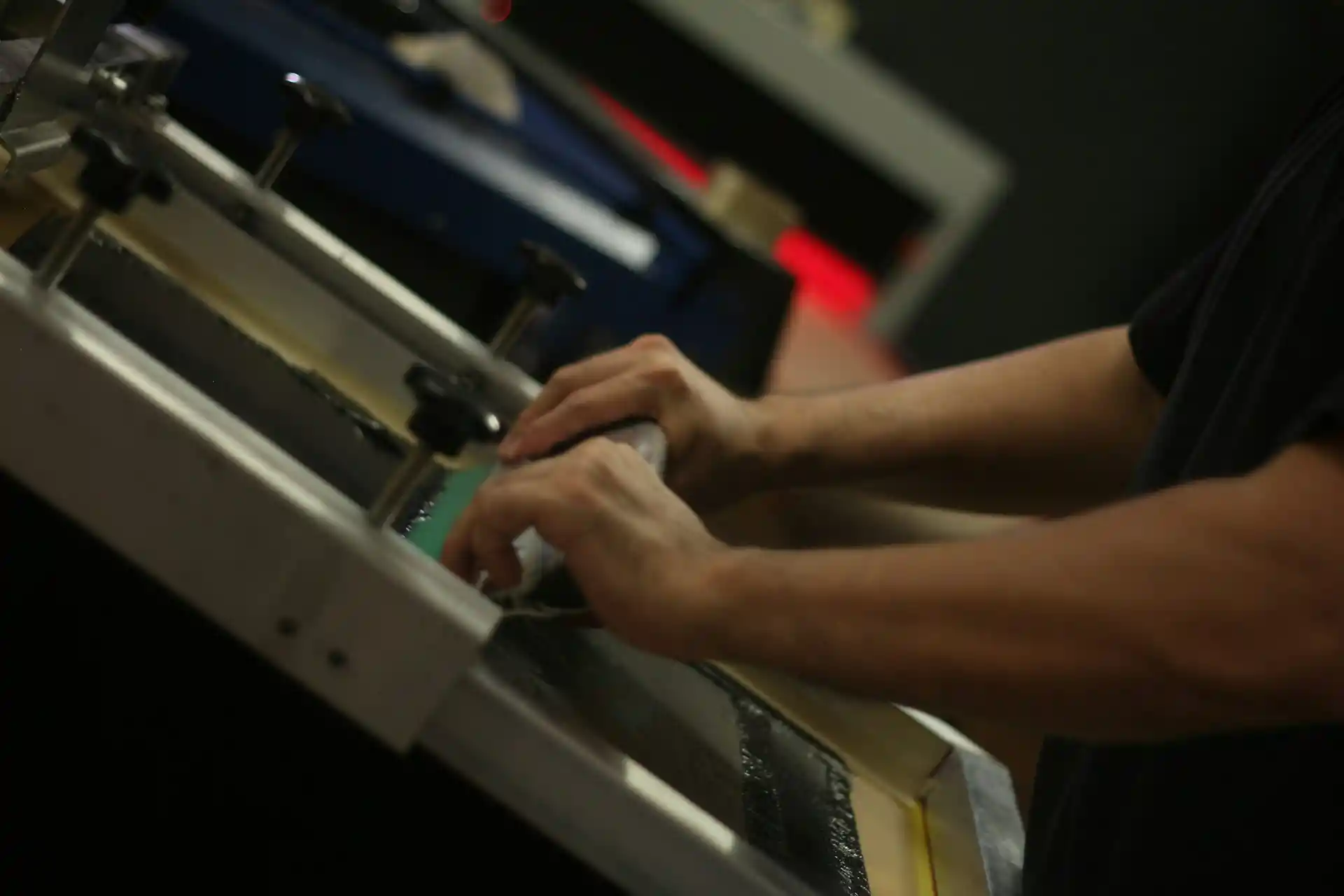
Silkscreen vs Embroidery: Key Differences
Appearance and Style
Embroidery
Embroidery gives your design a textured and raised look that instantly adds depth and class. Each stitch builds dimension, creating a tactile finish you can both see and feel.
Because the thread reflects light differently, colors appear slightly richer but less shiny than ink. Embroidery works best for simple shapes, logos, and text that need a polished, professional appearance.
It's ideal for branded uniforms or products meant to look timeless and high-end.
Silkscreen
Silkscreen creates a flat, vibrant surface that captures fine details and clean lines. Ink is pushed through a stencil onto the fabric, resulting in bold and even color coverage.
The finish can be glossy or matte depending on the ink type.
Silkscreen allows for subtle shading and smooth color transitions that embroidery cannot reproduce.
You'll often see it used for large, graphic-heavy T-shirts or promotional apparel that needs sharp visual impact.
Durability and Feel
Embroidery
Embroidery is built to last. The threads are tightly stitched into the material, making the design highly resistant to wear, washing, and sunlight.
It rarely fades or peels, even after years of use. On the downside, the back of the embroidery may feel rough, and the surface can be slightly stiff—especially on thin fabrics like jersey cotton.
Choosing the right backing and thread type can make it softer and more flexible for everyday wear.
Silkscreen
Silkscreen durability depends on ink quality and curing temperature. A properly cured print can last through dozens of washes without fading.
Over time, though, the ink layer might crack or lose brightness if the fabric stretches or if low-quality inks are used.
It feels lighter and smoother than embroidery, which makes it comfortable for wide-area prints like chest or back graphics. Water-based inks can make the finish even softer to the touch.
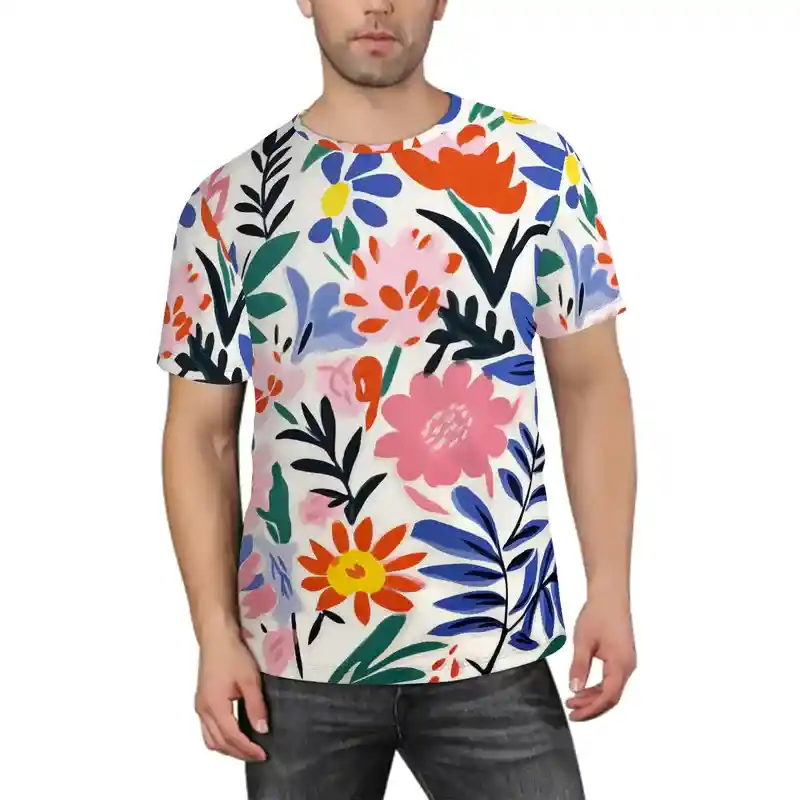
Print on Demand Men's Short-Sleeve T-Shirt Customized Services - Men's Clothing - PrintKK
Cost and Order Size
Embroidery
Embroidery requires digitizing, which converts your design into a stitch pattern. This setup step adds cost upfront.
Each stitch takes time, so complex designs with dense fills or many colors are more expensive. However, for small, simple logos on premium items, embroidery can be very cost-efficient and delivers a higher perceived value.
Bulk pricing helps too—the more you order, the lower the cost per piece becomes.
Silkscreen
Silkscreen involves making a separate screen for each color, so setup fees increase with multi-color designs.
But once the screens are ready, printing is fast and economical in volume. Large runs of shirts or hoodies become significantly cheaper per piece.
Small orders with many colors, however, can get pricey. If you're producing promotional or event apparel in bulk, silkscreen offers one of the best value-to-quality ratios.
Design Limitations
Embroidery
Embroidery can't replicate extremely small details or thin lines. Each stitch has a physical width, which limits precision.
Avoid gradients, fine textures, or very tiny letters—threads can merge together and lose clarity. You'll get the best outcome with bold fonts, solid blocks of color, and clean outlines.
Before production, designs often need to be simplified or resized to ensure they stitch cleanly on the chosen fabric.
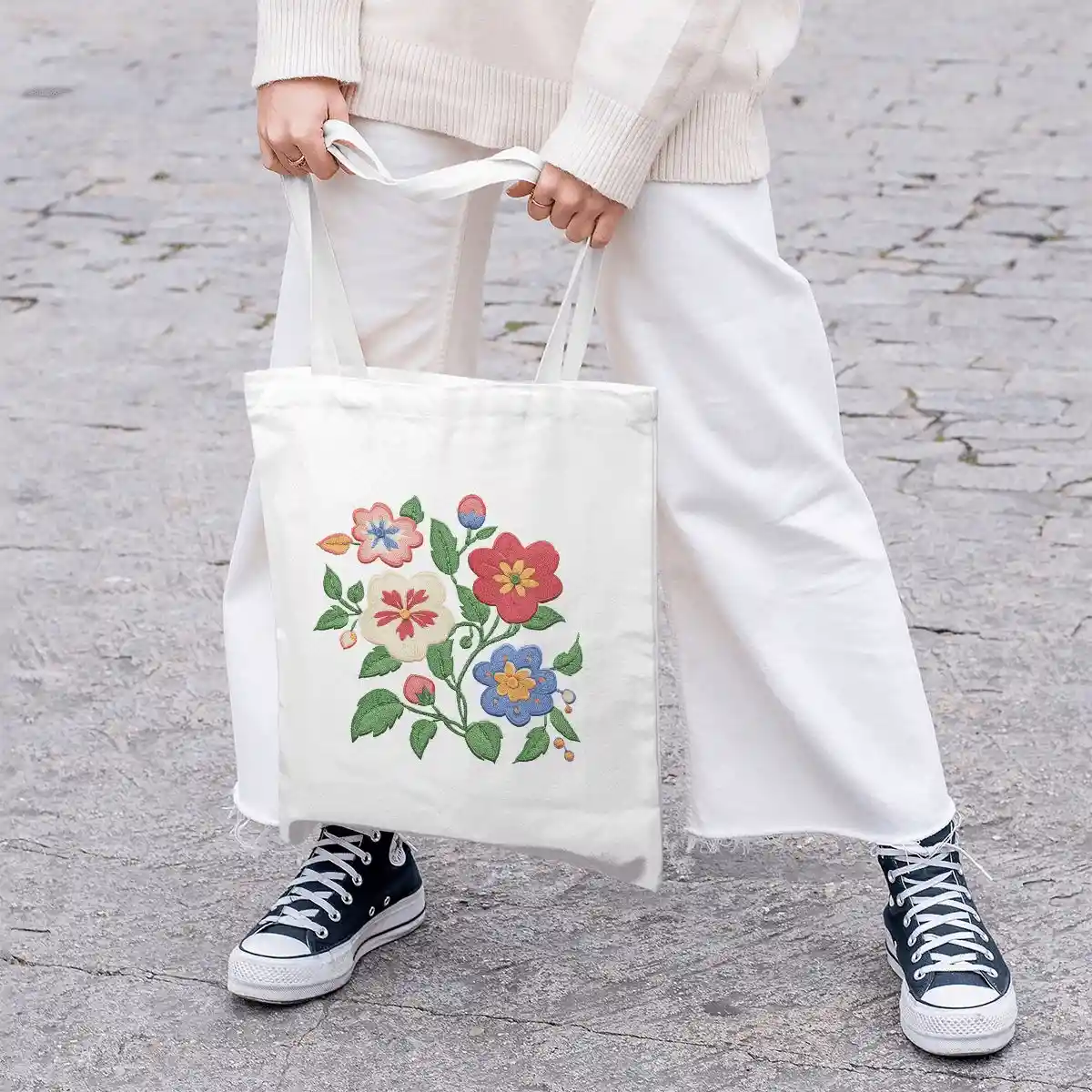
Custom Canvas Tote Bag (Made in USA)(Submit Shipping Label) - Print-On-Demand - PrintKK
Silkscreen
Silkscreen is far more flexible in design. It can handle tiny text, gradients, halftones, and intricate graphics with ease, provided the artwork is vectorized or high-resolution.
You can print photo-like images using specialized techniques. However, more colors mean more screens, which increases both setup time and cost.
Limiting color count can balance budget and design quality effectively.
Best Use Cases
Embroidery
Embroidery shines on thicker garments and accessories—polo shirts, jackets, caps, and bags. It communicates professionalism and durability, making it perfect for corporate uniforms, golf apparel, and branded workwear.
The 3D, stitched texture also stands out on items meant to last, like backpacks or towels. When you want your logo to feel premium rather than trendy, embroidery is the go-to option.
Silkscreen
Silkscreen is the choice for creative, colorful, and large-scale designs on lighter fabrics. It's ideal for T-shirts, hoodies, and tote bags where comfort and bold visuals matter.
You can experiment with ink types—metallic, glow-in-the-dark, puff, or water-based—for different looks.
If your goal is high-impact graphics for events, fashion, or merchandise, silkscreen printing gives you the freedom and flexibility to make your artwork stand out.
Silkscreen vs Embroidery: Which Is Best for Custom T-Shirts?
When deciding how to decorate your custom T-shirts, two of the most popular options are silkscreen printing and embroidery.
Each has its own advantages, limitations, and ideal use cases. The right choice for you will depend on several factors: artwork style, durability, cost, and order size.
1. Artwork & Design Type
The single most important factor is the type of artwork you want to reproduce.
Silkscreen printing (also called screen printing) works best for bold, graphic designs that use solid colors or simple gradients. It's ideal for logos, text, and artwork with clear color blocks.
- Typical range: 1–10 colors per design.
- Fine details and small text can be printed accurately, but very thin lines or intricate shading may require high mesh counts and expert registration.
- Great for large front or back prints that cover a wide area of the shirt.
Embroidery, by contrast, involves stitching your design directly into the fabric with colored threads.
This gives a textured, dimensional, and professional look—perfect for logos, emblems, and smaller design areas (like left chest, sleeves, or hats).
- It's best for simpler artwork, as each color change adds stitches and time.
- Photographic or gradient designs don't translate well, though certain tonal effects can be simulated with specialty threads or density changes.
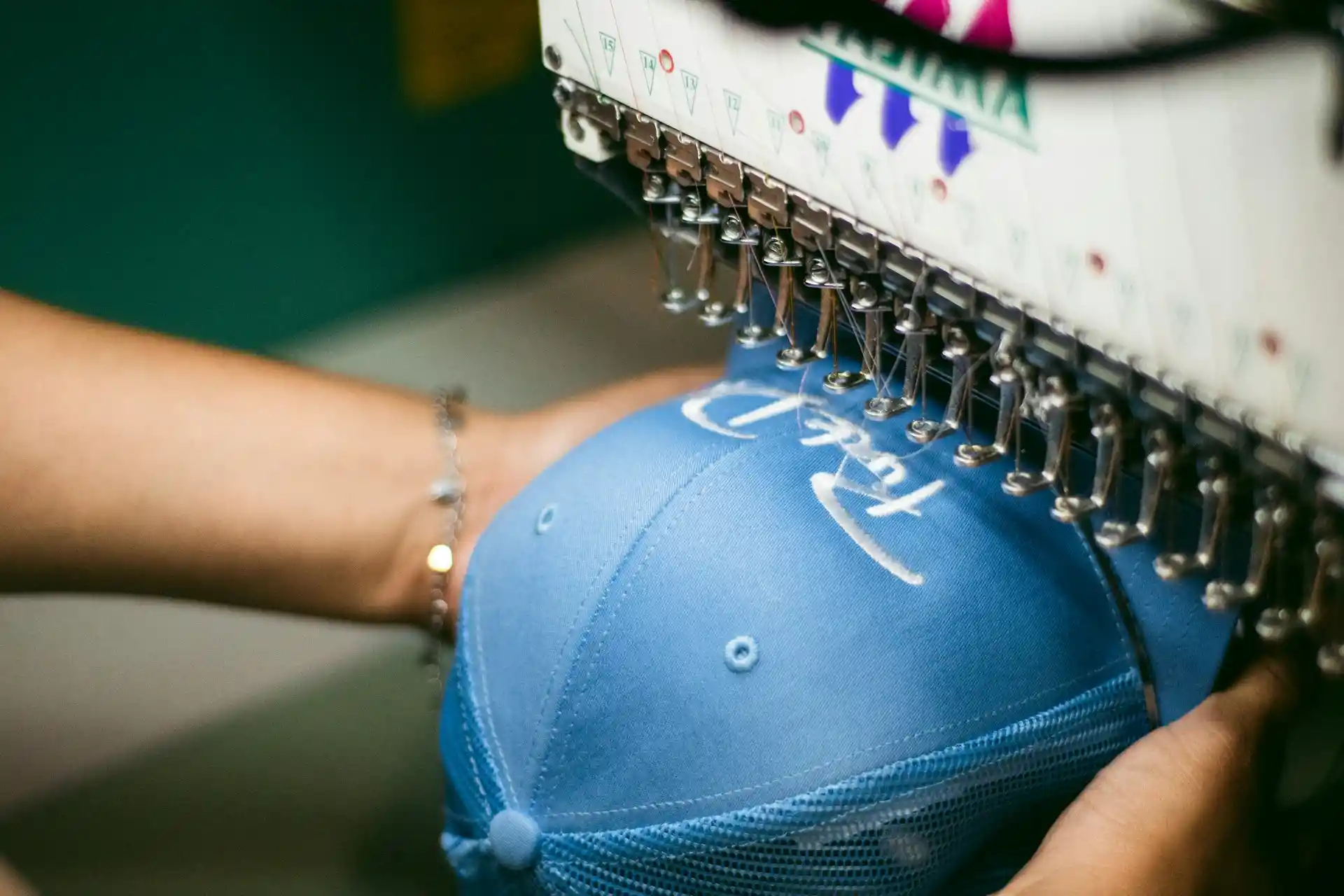
2. Cost & Order Size
Both methods vary in price, but for T-shirts, screen printing tends to be more cost-effective at scale, while embroidery offers premium quality at a higher unit cost.
Silkscreen Printing
- Requires setup of screens and color separations, which adds an initial fee.
- Once setup is complete, the cost per shirt drops significantly with larger orders—making it ideal for bulk runs (e.g., 25+ pieces).
- Adding more colors increases cost slightly, since each color requires its own screen.
Embroidery
- Priced mainly by stitch count—the more detailed or larger the design, the more stitches, and thus, the higher the price.
- Minimal setup cost after digitizing (creating a stitch file, usually one-time per logo).
- Cost per piece stays relatively consistent regardless of order size, so it's better suited for small to medium orders or premium apparel.
3. Durability & Maintenance
Both techniques are durable when done properly, but they age differently.
Silkscreen Prints
- High-quality plastisol or water-based inks can last for dozens of washes.
- Over time, heavy ink coverage can crack or fade if not cared for properly.
- To extend life, wash garments inside-out with cold water and avoid high heat drying.
Embroidery
- Exceptionally durable—the stitches are woven into the fabric itself.
- Can withstand repeated washing without fading, cracking, or peeling.
- However, embroidered areas may feel slightly raised or stiff, and large embroidered logos can sometimes pucker lightweight T-shirt fabric.
4. Fabric Compatibility
- Silkscreen printing works best on smooth, flat fabrics such as cotton or cotton blends. It's not ideal for thick textures or very stretchy materials.
- Embroidery looks sharp on heavier garments like polos, sweatshirts, or jackets, but can distort lightweight T-shirts unless proper stabilizers are used.
5. Overall Look & Feel
- Silkscreen gives a soft, printed feel (especially with water-based inks) and is perfect for casual or artistic T-shirt styles.
- Embroidery gives a premium, textured finish that conveys professionalism and permanence—great for corporate apparel or uniforms.
Quick Comparison Table
Feature | Silkscreen (Screen Print) | Embroidery |
Best for | Large, colorful, graphic designs | Small logos, text, and emblems |
Setup Cost | Moderate (screens per color) | One-time digitizing fee |
Cost Efficiency | Cheaper for bulk runs | Better for small orders |
Durability | Can fade or crack over time | Extremely durable; long-lasting |
Fabric Compatibility | Cotton, blends, smooth fabrics | Thicker fabrics, polos, jackets |
Texture/Feel | Flat or soft | Textured and raised |
Ideal Order Size | 25+ pieces | Any size, but fewer colors |
6. Bottom Line
- Choose silkscreen printing if you want bright, bold, full-front designs on casual shirts and need to print in volume.
- Choose embroidery if you want a premium, professional finish with exceptional longevity, especially for logos or branding on polos and heavier shirts.
How to Choose Between Embroidery and Silkscreen
Embroidery: Functions and Uses
- Logo and Branding
Embroidery is ideal for logos and brand marks. The stitched threads create a professional, textured look. It works best on polos, jackets, and uniforms where a premium feel matters.
- Corporate or Professional Apparel
Perfect for corporate shirts, hats, and jackets. Embroidery is durable and long-lasting, keeping logos sharp even after repeated washes.
- Event or Promotional Items
Works well for VIP gifts or staff uniforms. Embroidery adds a high-end impression, especially for small quantities. Large or detailed designs may increase cost.
- Sports and Team Apparel
Good for team logos or numbers on hats and jackets. Embroidery is resistant to washing, though large back designs can raise stitch costs.
- Specialty Items
Handles curved surfaces and thick fabrics like backpacks, hats, or jackets. Using stabilizers prevents puckering while keeping designs sharp.
- Decorative or Fashion Elements
Adds monograms, small patterns, or specialty threads (metallic, tonal effects). Best for premium detailing rather than full-shirt artwork.
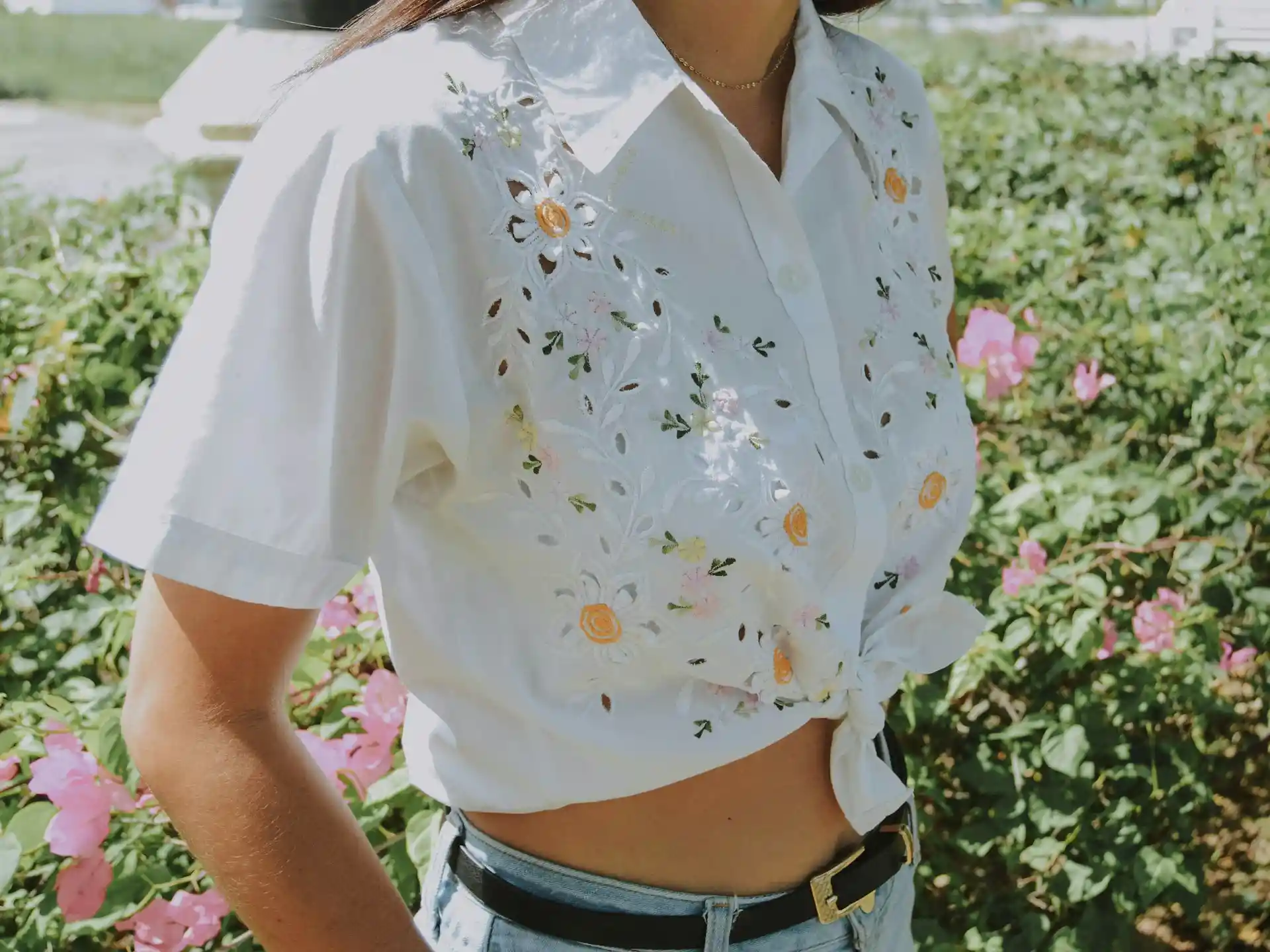
Silkscreen: Functions and Uses
- Logo and Branding
Silkscreen works for large, colorful logos. It can reproduce gradients and detailed graphics that embroidery cannot.
- Corporate or Promotional Apparel
Ideal for bulk orders like event shirts or giveaways. Silkscreen is cost-effective for large runs and works on casual apparel.
- Fashion and Artistic Designs
Perfect for creative designs, bold graphics, and photo-like images. Silkscreen allows multiple colors and complex patterns.
- Sports and Team Apparel
Great for jerseys, fan gear, and team T-shirts. Handles full-back numbers, multiple colors, and detailed graphics efficiently.
- Everyday or Casual Items
Works on T-shirts, hoodies, and tote bags. Prints vibrant, smooth designs on flat surfaces without affecting fabric feel.
- Special Effects
Supports metallic, glow-in-the-dark, and puff inks. Creates eye-catching textures and visual effects not possible with embroidery.
Which Type of Design Works Best for Silkscreen or Embroidery?
When choosing between silkscreen and embroidery, your design features matter. Line thickness, color count, and font size determine which method suits your logo best.
Design Complexity and Detail Level matters too. Silkscreen handles detailed designs and gradients well.
Embroidery works best for simple, bold logos. Very thin lines or tiny details can get lost in stitching, so keep shapes solid.
Text also affects your choice. Consider these rules:
Method | Minimum Text Height | Recommended Fonts |
Embroidery | ~5 mm (0.2 in) | Bold sans-serif (e.g. Arial) |
Silkscreen | ~2 mm (0.08 in) | Clean fonts, avoid ultra-thin |
Color and file preparation are important too. Silkscreen can print many colors and gradients, but each color requires its own screen.
Embroidery works best with solid thread colors, usually no more than six. Files differ as well: vector files (AI, SVG, EPS) suit silkscreen, while digitized stitch files (DST, PES) are needed for embroidery.
Here's a quick feature comparison:
Feature | Silkscreen | Embroidery |
Fine details | Great | Limited |
Small text | Good | Needs larger size |
Gradients | Possible | Not possible |
3D look | Flat | Raised texture |
Final takeaway: detailed and colorful designs go to silkscreen, while simple, bold logos are best for embroidery. Choosing based on these rules makes your garment look sharp and professional.
Expert Tips
Choosing between silkscreen vs embroidery depends on what you need for your project.
Think about design type, fabric, and how long you want it to last. Embroidery gives a premium, textured look and strong durability. Silkscreen offers bright, smooth prints and works well for larger or colorful designs.
Consider order size and cost too. Both methods have clear strengths. By knowing your priorities, you can pick the one that fits your style and purpose. Focus on what matters most for your shirts, and you'll get a result you like every time.
FAQs
Is silkscreen or embroidery better?
It depends on your design. Silkscreen works best for detailed, colorful graphics. Embroidery is ideal for simple logos with clear shapes. Consider fabric type, design complexity, and the look you want on your garment.
What lasts longer, silkscreen or embroidery?
Embroidery usually outlasts silkscreen because threads are stitched into the fabric. Silkscreen can fade or crack over time, especially with heavy washing. Proper care extends both, but embroidery holds up better in the long term.
Is silkscreen more affordable than embroidery?
Silkscreen is often cheaper for large orders because multiple items can be printed quickly. Embroidery requires more setup and time per piece, which increases costs, especially for small runs or highly detailed logos.
Is silkscreen outdated?
Silkscreen is still widely used and effective. While newer methods like DTG printing exist, silkscreen remains popular for vibrant colors, durability, and versatility on different fabrics, keeping it relevant today.


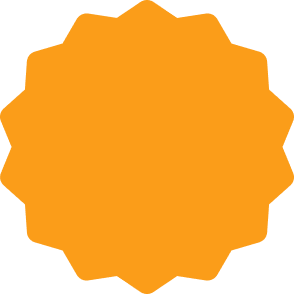







 Global Shipping
Global Shipping





























